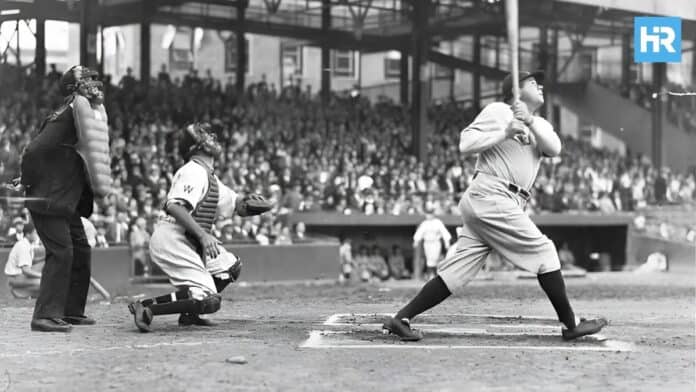George Herman Ruth Jr., known as Babe Ruth, was born on February 6, 1895, in Baltimore, Maryland. He became the most dominant and influential player in the history of Major League Baseball. Known by nicknames like “The Bambino” and “The Sultan of Swat,” Ruth hit 714 career home runs, won seven World Series titles, and helped turn baseball into America’s national sport.
To understand how Babe Ruth became a legend, we must start with his childhood.
- Babe Ruth changed baseball by introducing power-hitting. His home run records ended the dead-ball era and made offense the focus of the game.
- The Red Sox sold Ruth to the Yankees in 1919 for $100,000, which helped to build the Yankees into the most successful team in baseball history.
- Ruth became the first true sports celebrity in the U.S. His fame, records, and personality made him a national icon.
Troubled Childhood in Baltimore and Life at St. Mary’s School
Ruth’s early life was difficult. His parents, George Sr. and Kate Ruth, ran a saloon in a poor part of Baltimore. Out of their eight children, only Ruth and his sister Mamie survived. His parents were often absent, and Ruth began skipping school, drinking, and stealing at a young age.
In 1902, at age seven, he was sent to St. Mary’s Industrial School for Boys, a Catholic institution run by the Xaverian Brothers. Ruth lived there for most of the next 12 years. Brother Matthias Boutlier taught him discipline and baseball. Matthias became a father figure and helped Ruth develop his athletic ability, especially as a pitcher and hitter.
Signing with the Orioles and Earning the Name “Babe”
In 1914, Jack Dunn, owner of the minor-league Baltimore Orioles, signed Ruth to a $600 contract. Because Ruth was only 19, Dunn became his legal guardian to complete the deal. Players on the team referred to him as “Dunn’s babe,” and the name stuck.
Later that year, Dunn sold Ruth to the Boston Red Sox. Ruth made his Major League debut on July 11, 1914. He pitched in four games that season. The Red Sox then sent him to the Providence Grays, where he helped win the International League pennant.
Pitching Stardom with the Boston Red Sox (1915–1919)
Ruth quickly became one of baseball’s top pitchers. In 1915, he went 18–8 with a 2.44 ERA. In 1916, he led the league with a 1.75 ERA and won 23 games. In 1917, he had a 24–13 record with 35 complete games in 38 starts.
Between 1915 and 1919, Ruth won 87 games and had a career ERA of 2.16. He also performed well in the postseason, pitching 29⅔ consecutive scoreless innings across the 1916 and 1918 World Series.
By 1918, the Red Sox began using Ruth more as a hitter. He hit 11 home runs that year, tying for the league lead. In 1919, he hit 29 home runs, breaking the single-season record of 27, set in 1884 by Ned Williamson.
The Famous Trade to the Yankees
On December 26, 1919, Red Sox owner Harry Frazee sold Ruth to the New York Yankees for $100,000 and a $300,000 loan. Ruth signed a two-year contract with the Yankees for $10,000 per year.
In his first season with the Yankees in 1920, Ruth hit 54 home runs. No other player hit more than 19. Only the Philadelphia Phillies hit more as a team. In 1921, he hit 59 home runs, had 171 RBIs, scored 177 runs, batted .376, and posted a .846 slugging percentage.
The Yankees drew 1.29 million fans in 1920, setting a new attendance record. Ruth’s popularity made the team the most talked-about in baseball. In 1923, the Yankees opened Yankee Stadium, immediately dubbed “The House That Ruth Built.”
Breaking Records and Building the Yankees Dynasty (1923–1932)
In 1923, Ruth hit 41 home runs, batted .393, and had a .764 slugging percentage. He won the league MVP award and helped the Yankees win their first World Series title.
His production dropped in 1924 and 1925 due to illness, but from 1926 through 1932, Ruth averaged 49 home runs and 151 RBIs per season with a .353 batting average. The Yankees won four pennants and three World Series in that stretch.
In 1927, Ruth hit 60 home runs, setting a single-season record that stood until 1961. That year’s Yankees team, known as “Murderers’ Row,” featured Ruth and Lou Gehrig and is widely considered the greatest team in baseball history.
During the 1932 World Series against the Chicago Cubs, Ruth hit his most famous home run—his so-called “called shot.” According to the story, he pointed toward the center-field bleachers and then hit the next pitch to that exact location. While the details are still debated, the moment became part of his legend.
Decline, Final Season with the Braves, and Retirement
Ruth’s performance began to decline after 1932. He wanted to become the Yankees’ manager, but owner Jacob Ruppert refused, saying Ruth lacked discipline.
In 1935, Ruth joined the Boston Braves as a player and assistant manager. He played 28 games and hit six home runs. On May 25, he hit three home runs in a single game. He retired shortly afterward, finishing his career with 714 home runs, 2,214 RBIs, and a .342 lifetime batting average.
Hall of Fame, Health Decline, and Final Appearance
In 1936, Ruth was inducted into the newly established Baseball Hall of Fame as one of the first five members, along with Ty Cobb, Walter Johnson, Honus Wagner, and Christy Mathewson.
During retirement, Ruth made public appearances and endorsed various products. His agent, Christy Walsh, helped him manage his finances and image. In 1938, Ruth worked briefly as a coach for the Brooklyn Dodgers.
In 1946, Ruth was diagnosed with throat cancer. His condition worsened over time. On June 13, 1948, he made his last public appearance at Yankee Stadium during a ceremony to retire his number 3.
Babe Ruth died on August 16, 1948, in New York City at the age of 53. His body lay in state at Yankee Stadium, where over 100,000 people came to pay their respects. About 75,000 attended his funeral at St. Patrick’s Cathedral.
Babe Ruth’s Influence on Baseball and the Live-Ball Era
Ruth changed how baseball was played. Before him, teams relied on bunts, base stealing, and small-ball strategies. Ruth introduced power hitting, which became the centerpiece of the game.
From 1918 to 1921, stolen bases dropped from 1,989 to 1,487. Home runs increased from 235 to 937. Total runs rose from 7,382 to 11,928. Ruth’s rise also helped the game recover from the 1919 Black Sox scandal.
Between 1921 and 1932, the Yankees won seven American League pennants and four World Series titles. Ruth was the cornerstone of their success.
National Fame and Cultural Legacy
Ruth’s popularity reached beyond baseball. In 1920, The New York Times wrote that tourists wanted to see him as much as the Woolworth Building. The word “Ruthian” became part of the American language and was used to describe anything extraordinary.
His fame made him one of the first true sports celebrities. He appeared in films, supported charities, and made national headlines almost daily. He even became a symbol of American optimism during the Roaring Twenties and the Great Depression.






